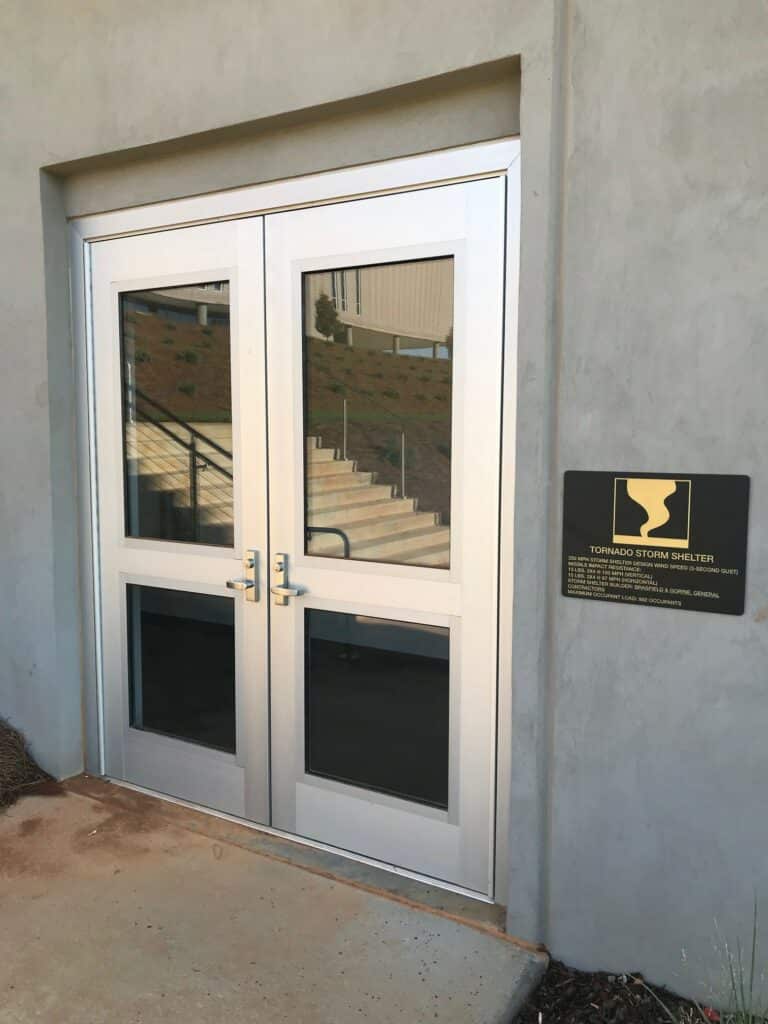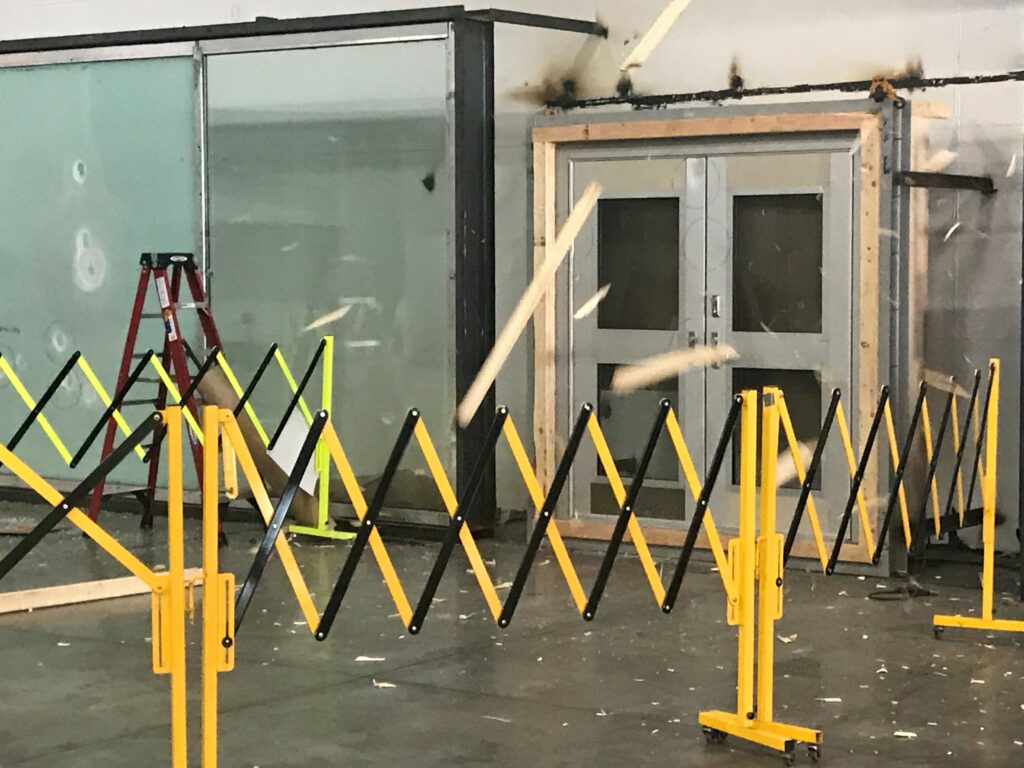
Tornado shelters are areas of a building or structures inside or outside of a building that are designed to keep occupants safe during an extreme weather event. The entire perimeter of this type of structure must be able to withstand extreme wind and impact from flying debris to provide maximum protection to those inside. This includes the doors used to enclose the space.
Though tornado shelter doors are just one element of a tornado shelter, they are a very important one. It’s important to consider both the safety and strength element of these products along with design and practical considerations. If you’re currently looking into tornado shelter doors for a community storm shelter structure, here’s a guide to some frequently asked questions.
What Types of Doors Can Be Used in Tornado Shelters?
There are various types of doors that can be used in tornado shelters. The specific products you choose are likely to depend on your design considerations and the type of storm shelter you’re constructing.
This term can apply to a number of different structures, from those in homes to those in large public buildings. The rest of this guide will focus mainly on safety considerations and testing requirements specifically meant for community storm shelters, which are those designed to protect large numbers of people – anywhere from about 16 to several hundred people. They’re often found in schools and other public buildings, and are required in certain settings within areas that are prone to extreme weather events.
However, some private businesses and commercial buildings also construct safe rooms or storm shelters that measure up to these standards simply to offer extra levels of protection inside their organizations.
In general, tornado shelter doors are often made of steel but glazed aluminum storefront-type doors that can withstand the high pressure and impact that often accompany extreme weather events are also available.
The exact products you choose can vary depending on your design requirements or considerations, which will be discussed more in depth below. However, the testing requirements and safety standards remain consistent based on the type of storm shelter or safe room being constructed and the wind zone or type of threat that is being protected against.
For doors used in community tornado shelters, building designers and decision-makers need to look for products that have been tested and certified by a recognized testing/certification body like Underwriters Laboratory. The relevant criteria for community storm shelter doors are ICC500-20 and FEMA361-21, which will be discussed more in-depth in the next section.
What Type of Testing Do Tornado Shelter Doors Undergo?
Tornado shelter doors must undergo similar testing as any other components that make up the envelope of a storm shelter, including windows, louvers, and shutters. Specifically, the entire door assembly must pass the required testing outlined under ICC500-20 and FEMA361-21. And all elements must pass these testing requirements in the same configuration in which they will be installed in the storm shelter or safe room setup.
This means that the door, frame, hardware, and any other elements that are to be used must be set up together exactly in the same order and arrangement during testing as they will appear while in use.

During the certification process for a series of door systems, the largest and smallest single and pairs of doors must undergo testing. There are several elements that may be included in the testing process based on the location and type of threat the door is meant to protect against.
However, one of the main testing elements is a missile test, which is designed to mimic the threat of flying debris striking the door or any other exterior elements of the storm shelter. More specifically, doors used in community storm shelters in 250 mph wind zones must be able to withstand impact from a 2×4 traveling at 100 mph.
The exact standards of each missile test vary based on the location and the type of safe room or storm shelter being constructed. However, this is one of the most rigorous testing requirements for ensuring protection against windborne debris.
Doors and other storm shelter components that are successfully certified will then have labels that are permanently attached to the assembly stating that they have been approved by a third-party certification agency like UL.
The certification process also includes verification after testing, listing of all approved door assembly components, and follow-up inspections for manufacturers.
What Are Some Design Considerations for Tornado Shelter Doors?
Once you have the important safety standards covered, it’s time to focus on the practical and aesthetic design elements. The first option that many people focus on is the door’s appearance and the materials used. Tornado shelter doors are often constructed using steel but glazed aluminum storefront-type doors that can stand up against pressure and impact are also available.
FEMA-361 doesn’t specify that certain substances must be used – only that they live up to the testing standards outlined within the guide. So you can find doors of various sizes, styles, colors, and finishes to suit the design standards of your building and fit in with the other materials used in the surrounding parts of your building.
When designing tornado shelter and safe rooms, it’s also important to consider the positioning of the door and how it will open. This decision really comes down to preference and how full the storm shelter or safe room is likely to be.
For instance, doors that swing outward can sometimes accommodate a few extra people, because you don’t need to account for door clearance. However, doors that swing inward are less likely to be blocked by debris, so they can sometimes create safer conditions once storms have passed. It is important to note that testing is directional so whether you require a door that swings inward or outward the door must be tested in that fashion.
Hardware is another design consideration that can make a major impact, design-wise. You can find hardware options in lots of different styles, sizes, and finishes to suit the aesthetic needs of your building. However, it is important that the hardware also meets the safety requirements. To be up to code, any hardware provided on a door must have been tested on the door and a part of the door’s listing.
What’s the Difference Between Doors Used for Community Safe Rooms and Storm Shelters?
Storm shelters and safe rooms are very similar structures that provide extra protection inside the structure of a public or commercial building. Both structures must meet all the relevant ICC 500 requirements. However, safe rooms must also meet FEMA P-361 guidelines as well. The full criteria for community safe rooms are outlined in the FEMA guide.
If you need tornado shelter doors for these important safety structures, contact Insulgard. Our knowledgeable team can provide quality options that are tested against the most rigorous industry standards, and we can walk you through the various considerations from design and sizing elements to installation. Visit our website to get started today.

